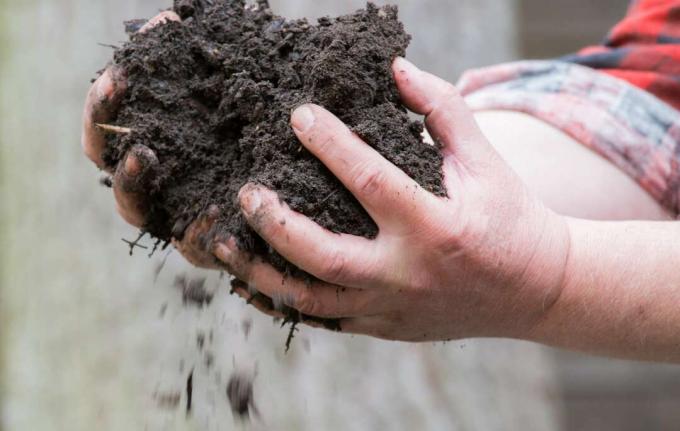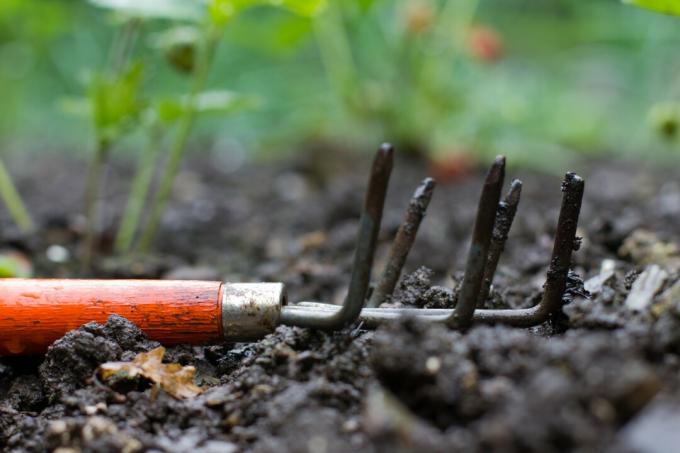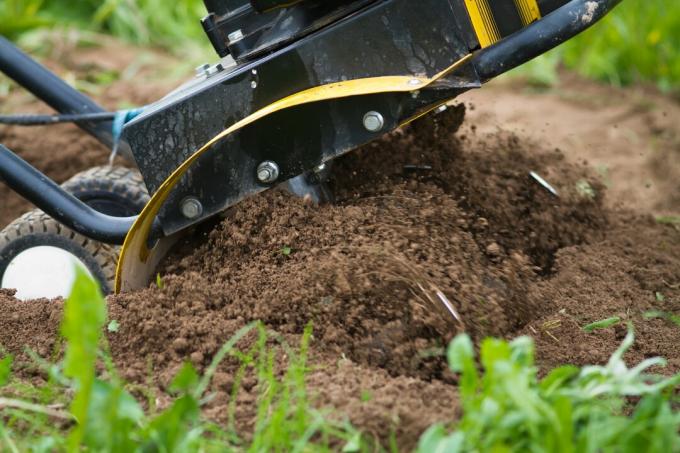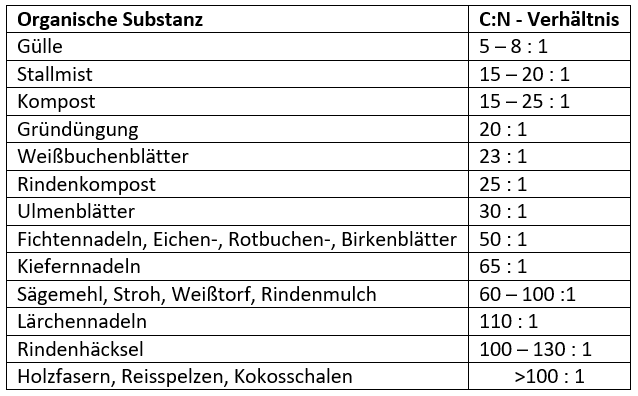Humus ensures good plant growth. You can find out how to ensure a rich yield of humus in your garden in our article.

The starting material for humus is dead organic matter. However, this can either be converted into humus or broken down into nutrients. The formation of humus is called humification, the breakdown and release of nutrients is called mineralization. The two processes should be in a balanced relationship to each other, so that there is enough humus is formed and sufficient nutrients are released to be available to the plants growing in the soil be able.
If you want to learn more about the processes of mineralization and humification, then you can here more information Find.
contents
-
Humus economy: guidance
- 1. soil pH
- 2. floor ventilation
- 3. Nutrient content of the soil and the substrate
- 4. soil temperature
- 5. water
- Humus economy: our conclusion
- Buy and receive humus
The humus economy is now concerned with balancing the relationship between humus formation and nutrient release. This ratio is influenced by many factors, which we will explain to you in more detail below. Soil organisms are always significantly involved, whether it is humified or mineralized depends crucially on their activity.
Humus economy: guidance
By observing the factors listed and described in detail below, you can actively influence and increase the formation of humus in your soil.
1. soil pH
Most soil dwellers love a neutral pH, so applying lime, which slightly raises the pH, can increase the activity of soil organisms. This can then lead to increased mineralization and possibly even to humus degradation. Conversely, a low pH value reduces the activity of microorganisms, sometimes even to the point that the organic material is only broken down by a few fungi. Very acidic soils are therefore often rich in humus but poor in nutrients because the organic material cannot be mineralized. This circumstance can be observed, for example, in the tropics or on acidic forest soils, where thick layers of only slightly decomposed organic material and so-called raw humus can be found.
If you want to influence the pH value, it makes sense to determine beforehand what the pH value of your own soil is. To do this, you can either send soil samples to a laboratory (e.g. at the Raiffeisen laboratory service) or test the soil yourself (e.g with pH indicator sticks or a pH meter) or you can find indicator plants in your own garden that show approximately how acidic the soil is is.


Since the pH value of the entire soil can hardly be influenced, the information should be handled as follows:
Soils that are already alkaline should never be limed. The microorganisms are already promoted by the high pH value. If calcium is applied as a plant nutrient then it should be applied in a slowly degradable form such as slag lime. If the soil is acidic (pH below 7), lime can be used without hesitation in order to fertilize calcium as a plant nutrient or to stimulate mineralization.
Nevertheless, in this case, too, one should refrain from applying organic fertilization directly after (e.g. with compost or horse droppings) to lime, otherwise the soil life mineralizes so quickly that a lot of humus is lost goes. It is better to wait at least a year before liming after using large amounts of organic fertilizer.
Some fertilizers also affect soil pH: nitrogen in the form of ammonium makes the soil more acidic, while nitrogen in the form of nitrate makes it more alkaline. So, when using these types of nitrogen fertilizers, consider alternating the form of nitrogen application if you don't want the soil pH to change.
2. floor ventilation
Most organisms that deal with the organic matter in the soil are aerobic (from Greek "aer" = air), which means that they need oxygen to survive. The more oxygen there is in the soil, the more active they are. A compacted or waterlogged soil contains only very little oxygen, so that a large number of microorganisms die off and less organic material is converted. To understand this, you only have to imagine a bog: that's why the peat can be so thick Layers arise because the degradation by microorganisms is inhibited by the lack of oxygen is.

There are many studies showing that the humus content of soils decreases when they are cultivated. This is partly due to the intensive processing. Due to the constant turning, cultivating, plowing and digging up, much more oxygen gets into the soil, so that the aerobic soil life is in top form and a lot of humus is converted. Although many nutrients are released in this way, the humus content decreases. Some farmers are therefore now using a gentler method instead of “turning tillage”, in which the soil is turned over Processing that involves less turning with a plow or tiller and more superficial loosening, the so-called "preserving tillage”.
So if you want to preserve your humus, you don't have to do too much milling or other work where the Soil is aerated too much and it is better to only dig up the bed once a year with a digging fork to cover the soil loosen. Superficial loosening before sowing, when working in fertilizer or hoeing to prevent weeds and water loss is of course permitted at any time.

3. Nutrient content of the soil and the substrate
The living space and at the same time the food of the organisms is called "substrate". The organic material that is decomposed is not only made up of nutrients, the largest proportion is made up of carbon. The ratio of carbon (C) and nitrogen (N) to each other is called the C/N ratio. Nitrogen is the basic food source for many soil organisms, while carbon is the "framework" from which everything organic is built, for example sugar, starch or cellulose in plant cells.
If the C/N ratio of the substrate is very large (i.e. a lot of carbon, little nitrogen), the Soil organisms have a lot of work to do - but little nitrogen as an energy source to cope with this job. Consequently, this material is not mineralized as quickly, so that in this case humus is more likely to be formed.
However, if the C/N ratio of the substrate is small (i.e. a lot of nitrogen, little carbon), the Soil organisms have enough nutrition in the form of nitrogen to immediately mineralize a lot of material - so it is formed less humus. Instead, many nutrients are released. The carbon skeleton of the converted material is released as carbon dioxide (CO2) released and leaves the ground. In general, woody plant material tends to have a high C/N ratio, while green, soft plant material tends to have a low C/N ratio.

Tip: From a C/N ratio of over 25: 1, degradation is inhibited, so that humus is more likely to form. At C/N ratios below 20:1, the organically bound nitrogen is quickly released.
When you fertilize your soil, you should therefore pay attention to the C/N ratio: if you apply a lot of nitrogen, you increase the activity of the soil organisms. To prevent them from breaking down your topsoil as a result, it is very important to offer them new carbon in the form of persistent organic matter. Simultaneous incorporation of chopped garden waste, wood chips, bark mulch or straw would be possible, for example. You can also subject this garden waste to rotting: the rotting process (e.g. on a compost heap) will The C/N ratio has been shifted a little bit towards N, so the softer structure means it can be better incorporated into your soil and will increase more quickly implemented hummus.
Organic material with a very low C/N ratio is quickly mineralized by the high nitrogen content, it should be treated more like a kind of fertilizer. Materials with a low C/N ratio are, for example, vegetable waste from the kitchen, liquid manure or manure and fresh lawn clippings.
If possible, you should fertilize organically - compost, horse manure with straw and also organic commercial fertilizers have a C/N ratio that promotes humus formation.
4. soil temperature
Soil creatures like it quite warm. The activity of soil life increases with temperature, provided there is also sufficient moisture in the soil. Actually, it is very positive when a floor warms up slightly. Plants then grow earlier in the year and also faster on it, the soil organisms supplying them with nutrients. However, it is problematic when a soil without vegetation heats up and the soil organisms diligently supply nutrients that no plant absorbs.
In this case, it can happen that nutrients are washed out with the rain or irrigation water where the plants can no longer use them and, in the worst case, the groundwater affect. At the same time, the humus in the soil escapes into the air in the form of carbon dioxide. If no plant parts then reach the soil that can replace the carbon that has disappeared, then the humus content of the soil naturally decreases. For this reason one should avoid that a soil remains completely bare, in case of doubt one can sow a green manure. On the one hand, the plants absorb nutrients, on the other hand, they fix the carbon from the air so that it gets back into the soil when the green manure is incorporated later. They also shade the ground with their foliage, keeping it cooler. If you cannot or do not want to spread green manure, you should think about covering the area with a layer of mulch.

5. water
Like all living things, soil dwellers need water, not only because it is part of their bodies, but also because they can move better in moist soil. In addition, many important chemical processes can only take place if it is humid enough. In soils that are too dry, little or no organic material is converted. Too much water, on the other hand, causes the soil dwellers to run out of oxygen, which also leads to inhibited conversion. Of course, how much water is applied to a soil depends primarily on the plants that grow on it. Orienting this factor to the soil organisms would not be optimal. It can therefore always be cast as required.
Humus economy: our conclusion
If you want to build up humus, you should lime sparingly so as not to increase the pH of your soil too much. In order to avoid excessive aeration, the soil should be worked with as little turning and mixing as possible, but only loosening. It is very important to pay attention to the even supply of poorly degradable organic material with every fertilization. Ground should also never lie fallow and be unshaded.
tip: If you want to stimulate soil life, you can also use a so-called soil activator. Our Plantura Organic soil activator contains living mycorrhizal fungi that stimulate activity in the soil and thus ensure a healthy and fertile subsoil in the long term.
Buy and receive humus
Promoting the formation of humus in your garden as described above is too time-consuming, tedious and complicated for you? Then you can of course simply buy hummus. We have what needs to be considered in a separate article summarized for you.
